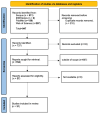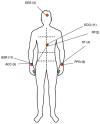Wearable Solutions Using Physiological Signals for Stress Monitoring on Individuals with Autism Spectrum Disorder (ASD): A Systematic Literature Review
- PMID: 39771872
- PMCID: PMC11679670
- DOI: 10.3390/s24248137
Wearable Solutions Using Physiological Signals for Stress Monitoring on Individuals with Autism Spectrum Disorder (ASD): A Systematic Literature Review
Abstract
Some previous studies have focused on using physiological signals to detect stress in individuals with ASD through wearable devices, yet few have focused on how to design such solutions. Wearable technology may be a valuable tool to aid parents and caregivers in monitoring the emotional states of individuals with ASD who are at high risk of experiencing very stressful situations. However, effective wearable devices for individuals with ASD may need to differ from solutions for those without ASD. People with ASD often have sensory sensitivity and may, therefore, not tolerate certain types of accessories and experience discomfort when using them. We used the Scopus, PubMed, WoS, and IEEE-Xplore databases to search for studies published from 2014 to 2024 to answer four research questions related to wearable solutions for individuals with ASD, physiological parameters, and techniques/processes used for stress detection. Our review found 31 articles; not all studies considered individuals with ASD, and some were beyond the scope of this review. Most of the studies reviewed are based on cardiac activity for stress monitoring using photoplethysmography (PPG) and electrocardiography (ECG). However, limitations include small sample sizes, variability in study conditions, and the need for customization in stress detection algorithms. In addition, there is a need to customize the stress threshold due to the device's high individual variability and sensitivity. The potential of wearable solutions for stress monitoring in ASD is evident, but challenges include the need for user-friendly and unobtrusive designs and integrating these technologies into comprehensive care plans.
Keywords: autism spectrum disorder; biomedical sensors; emotion detection; physiological signals; stress detection; wearable technology.
Conflict of interest statement
The authors declare no conflicts of interest.
Figures
Similar articles
-
Pharmacological intervention for irritability, aggression, and self-injury in autism spectrum disorder (ASD).Cochrane Database Syst Rev. 2023 Oct 9;10(10):CD011769. doi: 10.1002/14651858.CD011769.pub2. Cochrane Database Syst Rev. 2023. PMID: 37811711 Free PMC article.
-
The Lived Experience of Autistic Adults in Employment: A Systematic Search and Synthesis.Autism Adulthood. 2024 Dec 2;6(4):495-509. doi: 10.1089/aut.2022.0114. eCollection 2024 Dec. Autism Adulthood. 2024. PMID: 40018061 Review.
-
Telehealth interventions: remote monitoring and consultations for people with chronic obstructive pulmonary disease (COPD).Cochrane Database Syst Rev. 2021 Jul 20;7(7):CD013196. doi: 10.1002/14651858.CD013196.pub2. Cochrane Database Syst Rev. 2021. PMID: 34693988 Free PMC article.
-
Signs and symptoms to determine if a patient presenting in primary care or hospital outpatient settings has COVID-19.Cochrane Database Syst Rev. 2022 May 20;5(5):CD013665. doi: 10.1002/14651858.CD013665.pub3. Cochrane Database Syst Rev. 2022. PMID: 35593186 Free PMC article.
-
Parent-mediated early intervention for young children with autism spectrum disorders (ASD).Cochrane Database Syst Rev. 2013 Apr 30;2013(4):CD009774. doi: 10.1002/14651858.CD009774.pub2. Cochrane Database Syst Rev. 2013. PMID: 23633377 Free PMC article.
Cited by
-
Challenging Behaviors in Children with Nonverbal Autism: A Questionnaire to Guide the Design of a Wearable Device for Biomarker Recording.Sensors (Basel). 2025 Mar 23;25(7):2009. doi: 10.3390/s25072009. Sensors (Basel). 2025. PMID: 40218521 Free PMC article.
-
From motion to emotion: exploring challenging behaviors in autism spectrum disorder through analysis of wearable physiology and movement.Physiol Meas. 2025 Jan 29;13(1):015004. doi: 10.1088/1361-6579/ada51b. Physiol Meas. 2025. PMID: 39746311 Free PMC article.
-
Wearable Sensors for Ensuring Sports Safety in Children with Autism Spectrum Disorder: A Comprehensive Review.Sensors (Basel). 2025 Feb 26;25(5):1409. doi: 10.3390/s25051409. Sensors (Basel). 2025. PMID: 40096194 Free PMC article. Review.
References
-
- American Psychiatric Association . Diagnostic and Statistical Manual of Mental Disorders. 5th ed. American Psychiatric Association; Richmond, VA, USA: 2013.
Publication types
MeSH terms
LinkOut - more resources
Full Text Sources
Medical






